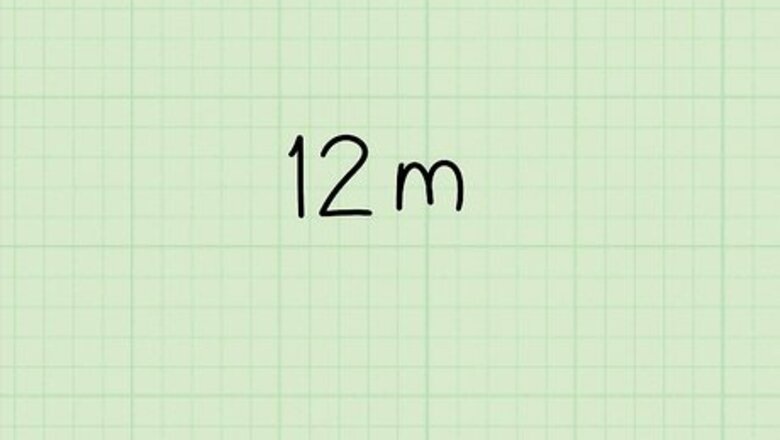
views
Quickly Converting
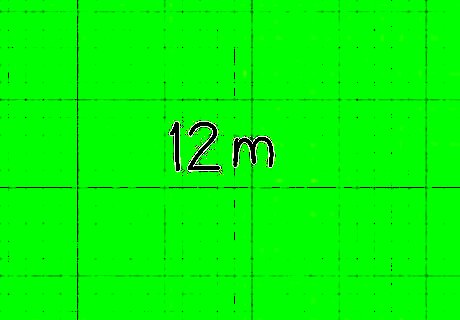
Note the number of meters you want to convert. A conversion from meters to yards is nothing but a simple multiplication operation. All you need to do is start with a number of meters.
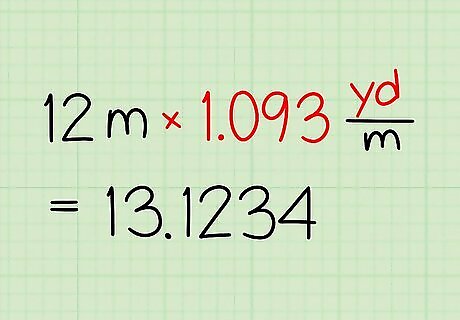
Multiply the number of meters by 1.0936 to get the number of yards. There are 1.0936 yards in every meter. So if 1 meter is 1.0963 yards, then 2 meters is 2.1872 yards, and so on. You could keep adding 1.0936 yards for each additional meter, but the easiest way to do it is by multiplication: For example, convert 12 meters into yards. 12 m ∗ 1.0936 y a r d s m e t e r s = 13.1234 {\displaystyle 12m*1.0936{\frac {yards}{meters}}=13.1234} 12m*1.0936{\frac {yards}{meters}}=13.1234
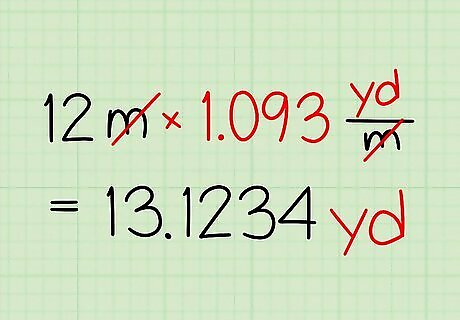
Provide your "units" at the end to complete the problem. In the example, you determined the answer was "13.1234." But on a test or a project you need to be sure to answer the simple question, "13.1234 of what?" The answer, of course, is 13.1234 yards, but don't forget to add these units to get full credit.
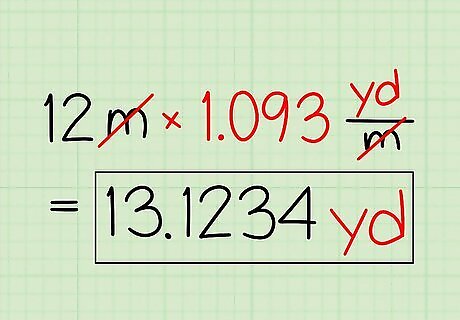
So to convert 12 meters into yards, multiply 12 meters by 1.0936 yards per meter. 12 m ∗ 1.0936 y a r d s m e t e r s = 13.1234 {\displaystyle 12m*1.0936{\frac {yards}{meters}}=13.1234} 12m*1.0936{\frac {yards}{meters}}=13.1234 12 m e t e r s = 13.1234 y a r d s {\displaystyle 12meters=13.1234yards} 12meters=13.1234yards
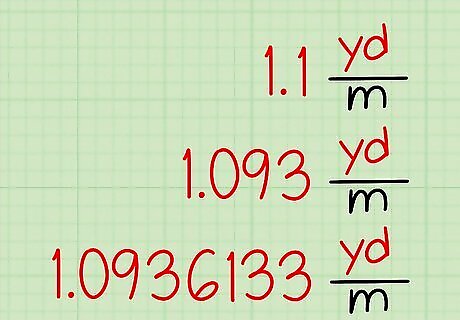
Use more or fewer decimal places to get a more precise or less precise answer. The formula "1 meter = 1.0936 yards" is just an approximation. The most accurate conversion factor is an infinite string of numbers. The more decimal places you use, the more precise the conversion will be. However, it would be a rare case where four decimal places wouldn't be enough. For example, you could also use the following: Rough Calculation: 1 meter = 1.1 yards Fairly Precise Calculation: 1 meter = 1.0936 yards Extremely Precise Calculation: 1 meter = 1.0936133 yards
Estimating Without a Calculator
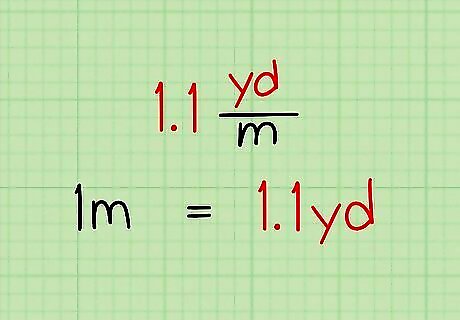
Get used to the idea that for estimation purposes 1 meter = 1.1 yards. As noted above, the actual conversion is closer to 1.0936 yards, but you can round this number up slightly to make it easier to calculate by hand. While 1.1 slightly exceeds the actual conversion, it is only by .0064 yard -- not enough to throw off a basic estimation. Though this method is close, remember that your estimation will be slightly larger than the actual conversion.
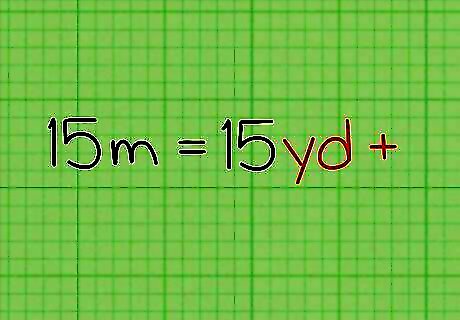
Write down the number of meters followed by a plus sign. Meters and yards are almost the exact same length. The difference is in the .1, which is easy to calculate. Since anything multiplied by 1 is itself ( 1 ∗ 15 = 15 {\displaystyle 1*15=15} 1*15=15), all you need to do is find the .1 portion and add it to the number of meters. For example, estimate the number of yards in 15 meters. 15 meters = 15 yards + ?
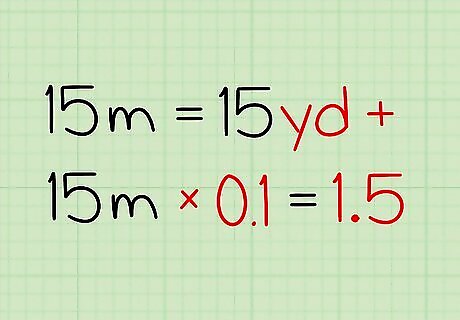
Multiply the number of meters by .1. Do this by moving the decimal point one place to the left. Simply take the number of meters and shift the decimal point one place to the left -- this is the exact same thing as "multiplying by .1" So in this example: Estimate the number of yards in 15 meters. 15 m e t e r s = 15 y a r d s + {\displaystyle 15meters=15yards+} 15meters=15yards+ ? 15 m e t e r s ∗ .1 = 1.5 {\displaystyle 15meters*.1=1.5} 15meters*.1=1.5
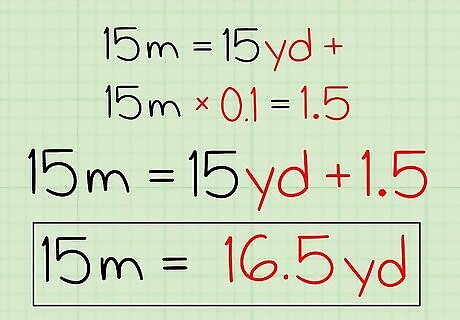
Add the new number to the original number of meters to get your final answer. The only math you have to do at this point is some quick addition. Once you've moved the decimal point over, add this new number to the original number of meters. For example: Estimate the number of yards in 15 meters. 15 m e t e r s = 15 y a r d s + {\displaystyle 15meters=15yards+} 15meters=15yards+ ? 15 m e t e r s ∗ .1 = 1.5 {\displaystyle 15meters*.1=1.5} 15meters*.1=1.5 15 m e t e r s = 15 y a r d s + 1.5 {\displaystyle 15meters=15yards+1.5} 15meters=15yards+1.5 15 m e t e r s = 16.5 y a r d s {\displaystyle 15meters=16.5yards} 15meters=16.5yards
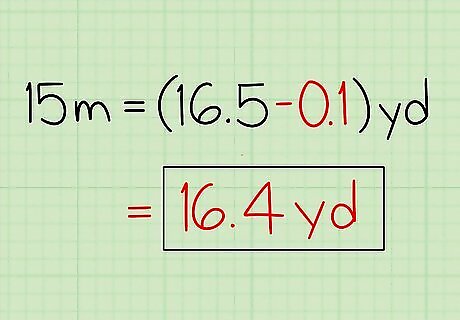
Consider subtracting your overestimation for an even more precise estimate. The actual conversion of 15 meters is 16.4042 yards, meaning the estimation was only about .1 yard off. Note that the overestimation will get bigger if you're working with bigger numbers. 150 meters would be estimated at 165 yards, and that's 1.6 yards too high. A good way to eliminate this over-estimation is to subtract .1 yard for every ten yards: In the first example, you have 16.5 yards. To correct it, you can subtract .1, because there is only one "10" in 16. Your final estimation would be 16.4 yards. For the bigger example, you'd subtract 1.6 yards, because there are sixteen "10s" in 165. The estimate this time would be 163.4 yards.
















Comments
0 comment